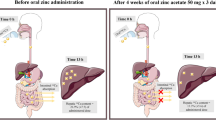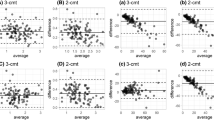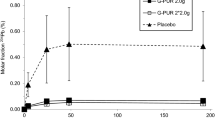Abstract
Background/Objectives:
Serum or tissue zinc concentrations are often used to assess body zinc status. However, all of these methods are relatively inaccurate. Thus, we investigated three different kinetic methods for the determination of zinc clearance to establish which of these could detect small changes in the body zinc status of children.
Subjects/Methods:
Forty apparently healthy children were studied. Renal handling of zinc was investigated during intravenous zinc administration (0.06537 mg Zn/kg of body weight), both before and after oral zinc supplementation (5 mg Zn/day for 3 months). Three kinetic methods were used to determine zinc clearance: CZn-Formula A and CZn-Formula B were both used to calculate systemic clearance; the first is a general formula and the second is used for the specific analysis of a single-compartment model; CZn-Formula C is widely used in medical practices to analyze kinetic routine.
Results:
Basal serum zinc values, which were within the reference range for healthy children, increased significantly after oral zinc supplementation. The three formulas used gave different results for zinc clearance both before and after oral zinc supplementation. CZn-Formula B showed a positive correlation with basal serum zinc concentration after oral supplementation (R2=0.1172, P=0.0306). In addition, CZn-Formula B (P=0.0002) was more effective than CZn-Formula A (P=0.6028) and CZn-Formula C (P=0.0732) in detecting small variations in body zinc status.
Conclusions:
All three of the formulas used are suitable for studying zinc kinetics; however, CZn-Formula B is particularly effective at detecting small changes in body zinc status in healthy children.
This is a preview of subscription content, access via your institution
Access options
Subscribe to this journal
Receive 12 print issues and online access
$259.00 per year
only $21.58 per issue
Buy this article
- Purchase on Springer Link
- Instant access to full article PDF
Prices may be subject to local taxes which are calculated during checkout






Similar content being viewed by others
References
Stefanidou M, Maravelias C, Dona A, Spiliopoulou C . Zinc: a multipurpose trace element. Arch Toxicol 2006; 80: 1–9.
de Benoist B, Darnton-Hill I, Davidsson L, Fontaine O, Hotz C . Conclusions of the joint WHO/UNICEF/IAEA/IZiNCG interagency meeting on zinc status indicators. Food Nutr Bull 2007; 28: S480–S484.
Lowe NM, Fekete K, Decsi T . Methods of assessment of zinc status in humans: a systematic review. Am J Clin Nutr 2009; 89: 2040S–2051SS.
Ryu MS, Langkamp-Henken B, Chang SH, Shankar MN, Cousins RJ . Genomic analysis, cytokine expression, and microRNA profiling reveal biomarkers of human dietary zinc depletion and homeostasis. Proc Natl Acad Sci USA 2011; 108: 20970–20975.
Nakamura T, Higashi A, Nishiyama S, Fujimoto S, Matsuda I . Kinetics of zinc status in children with IDDM. Diabetes Care 1991; 14: 553–557.
Leite LD, Rocha EDM, Almeida MG, Rezende AA, da Silva CA, França MC et al. Sensitivity of zinc kinetics and nutritional assessment of children submitted to venous zinc tolerance test. J Am Coll Nutr 2009; 28: 405–412.
Santos MG, Baracho MD, Vale SH, Leite LD, Rocha ED, de Brito NJ et al. Kinetics of zinc status and zinc deficiency in Berardinelli-Seip syndrome. J Trace Elem Med Biol 2012; 26: 7–12.
International Zinc Nutrition Consultative Group (IZiNCG), Brown KH, Rivera JA, Bhutta Z, Gibson RS, King JC et al. Assessment of the risk of zinc deficiency in populations and options for its control. Food Nutr Bull 2004; 25: S99–203.
Gibson RS, Hess SY, Hotz C, Brown KH . Indicators of zinc status at the population level: a review of the evidence. Br J Nutr 2008; 99: S14–S23.
Edginton AN, Schmitt W, Voith B, Willmann S . A mechanistic approach for the scaling of clearance in children. Clin Pharmacokinet 2006; 45: 683–704.
Nakamura T, Nishiyama S, Futagoishi-Suginohara Y, Matsuda I, Higashi A . Mild to moderate zinc deficiency in short children: effect of zinc supplementation on growth velocity. J Pediatr 1993; 123: 65–69.
Kaji M, Gotoh M, Tagaki Y, Masuda H, Kimura Y, Uenoyama Y . Studies to determine the usefulness of the zinc clearance test to diagnose marginal zinc deficiency and the effects of oral zinc supplementation for short children. J Am Coll Nutr 1998; 17: 388–391.
King JC, Shames DM, Woodhouse LR . Zinc homeostasis in humans. J Nutr 2000; 130: 1360S–1366SS.
Brandão-Neto J, Silva C, Shuhama T, Silva JA, Oba L . Renal handling of zinc in insulin-dependent diabetes mellitus patients. Biometals 2001; 14: 75–80.
Brandão-Neto J, Silva CAB, Rezende AA, Almeida MG, Sales VSP, Marchini JS . Zinc pharmacokinetics in insulin-dependent diabetes mellitus patients after oral zinc tolerance test. Nutr Res 2003; 23: 141–150.
PK Solutions 2.0TM Summit Research Services. Pharmacokinetics and Metabolism Software. Internet: http://www.summitpk.com/2012.
Bauer LA . Applied Clinical Pharmacokinetics 2nd edn. McGraw Hill: New York, 2008.
Ritschel WA, Kearns GL . Handbook of Basic Pharmacokinetics... Including Clinical Applications 7th edn. American Pharmacists Association: Washington, 2009.
Berdanier CD . Advanced nutrition:Micronutrients. CRC Press: Boca Ratón, 1998.
Hess SY, Peerson JM, King JC, Brown KH . Use of serum zinc concentration as an indicator of population zinc status. Food Nutr Bull 2007; 28: S403–S429.
Nakamura T, Higashi A, Takano S, Akagi M, Matsuda I . Zinc clearance correlates with clinical severity of Crohn's disease. A kinetic study. Dig Dis Sci 1988; 33: 1520–1524.
Tomat AL, Costa MA, Arranz CT . Zinc restriction during different periods of life: Influence in renal and cardiovascular diseases. Nutrition 2011; 27: 392–398.
Acknowledgements
We would like to thank Alfredo de Araújo Silva for his invaluable technical assistance. This study was supported by the National Council for Scientific and Technological Development (CNPq), grant number 472832/2011-5.
Author information
Authors and Affiliations
Corresponding author
Ethics declarations
Competing interests
The authors declare no conflict of interest.
Rights and permissions
About this article
Cite this article
Vale, S., Leite, L., Alves, C. et al. Zinc pharmacokinetic parameters in the determination of body zinc status in children. Eur J Clin Nutr 68, 203–208 (2014). https://doi.org/10.1038/ejcn.2013.250
Received:
Revised:
Accepted:
Published:
Issue Date:
DOI: https://doi.org/10.1038/ejcn.2013.250



